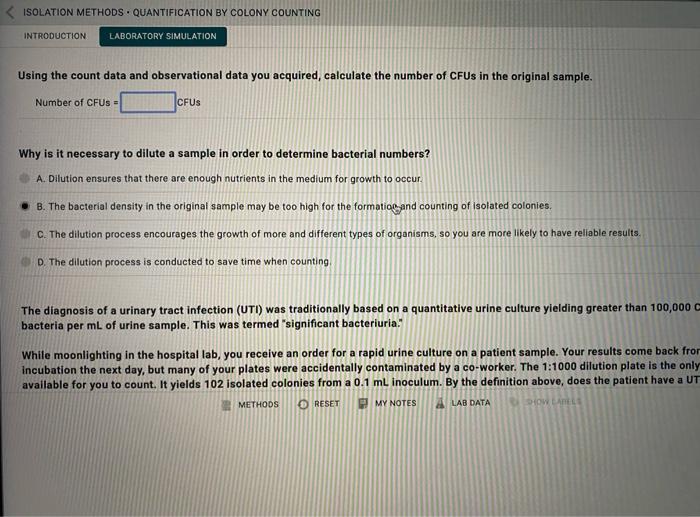
< ISOLATION METHODS. QUANTIFICATION BY COLONY COUNTING INTRODUCTION LABORATORY SIMULATION Using the count data and observational data you acquired, calculate the number of CFUs in the original sample. Number of CFUS = CFUS Why is it necessary to dilute a sample in order to determine bacterial numbers? A. Dilution ensures that there are enough nutrients in the medium for growth to occur. • B. The bacterial density in the original sample may be too high for the formation and counting of isolated colonies. C. The dilution process encourages the growth of more and different types of organisms, so you are more likely to have reliable results. D. The dilution process is conducted to save time when counting The diagnosis of a urinary tract infection (UTI) was traditionally based on a quantitative urine culture yielding greater than 100,000 bacteria per mL of urine sample. This was termed significant bacteriuria. While moonlighting in the hospital lab, you receive an order for a rapid urine culture on a patient sample. Your results come back fror incubation the next day, but many of your plates were accidentally contaminated by a co-worker. The 1:1000 dilution plate is the only available for you to count. It yields 102 isolated colonies from a 0.1 mL inoculum. By the definition above, does the patient have a UT METHODS O RESET MY NOTES A LAB DATA DOWLANELE
Netflix Courses Lab: Quantification of Bacteria - Colon INTIFICATION BY COLONY COUNTING RY SIMULATION How to Calculate Bacterial Concentration in Original Sample x ere are enough nutrient the original sample ma You will be able to use the counted number to back-calculate (extrapolate) the amount of bacterial cells in the original sample. Take the number of counted colonies and multiply by the dilution factor For example, if 67 colonies are counted on a plate that received 1.0 mL of the 1:1,000,000 dilution, the calculation would be: (67 CFU/mL x 1,000,000 dilution factor) = 67 x 106 bacteria per mL of undiluted culture Us of Label Growth Appe When calculating original sample concentration, remember to account for the fact that growth is usually reported as CFU per ml, which means if your aliquot to a dilution plate is less than 1.0 mL, you must correct to the standard amount of 1ml. Heavy Heavy pne 0 Intermediate For example, if 141 colonies are counted on a plate that received only 0.1 mL of the 1:1,000,000 dilution, the calculation would be: (141 CFU/mL x 1,000,000 dilution factor) x 10 correction factor = 1.41 x 10° bacteria per mL of undiluted culture 00 Scant Nould Plate 3 Zo Selected For Counting 0.1 ne of Diluted Sample (mL) 1:1,000,000
< ISOLATION METHODS. QUANTIFICATION BY COLONY COUNTING INTRODUCTION LABORATORY SIMULATION Using the count data and observational data you acquired, calculate the number of CFUs in the original sample. Number of CFUS = CFUS Why is it necessary to dilute a sample in order to determine bacterial numbers? A. Dilution ensures that there are enough nutrients in the medium for growth to occur. • B. The bacterial density in the original sample may be too high for the formation and counting of isolated colonies. C. The dilution process encourages the growth of more and different types of organisms, so you are more likely to have reliable results. D. The dilution process is conducted to save time when counting The diagnosis of a urinary tract infection (UTI) was traditionally based on a quantitative urine culture yielding greater than 100,000 bacteria per ml of urine sample. This was termed significant bacteriuria. While moonlighting in the hospital lab, you receive an order for a rapid urine culture on a patient sample. Your results come back fror incubation the next day, but many of your plates were accidentally contaminated by a co-worker. The 1:1000 dilution plate is the only available for you to count. It yields 102 isolated colonies from a 0.1 ml inoculum. By the definition above, does the patient have a UT METHODS O RESET MY NOTES DOWLANE A LAB DATA
The bacterial density in the original sample may be too high for the formation and Xesults. A Lab Data Phase 1 Countable? er than 100,000 Isolated Colonies Present? Plate # Dilution Label Growth Appearance on Plate 114 er Too numerous to count No 1 1:10,000 Heavy Too numerous to count Yes, few 2 1:100,000 Heavy ts come back n plate is the a patient have a Countable a Yes, many 3 Intermediate 1:1,000,000 Too few to count Yes, few 4 1:10,000,000 Scant than 100,000". Save image afe Image Plate 3 0.1 TPhase 2 - Т Plate Selected For Counting Volume of Diluted Sample (mL) Sample Dilution Colony Count 1:1,000,000 54 How to Calculate Bacterial Concentration in Original Sample
没有找到相关结果